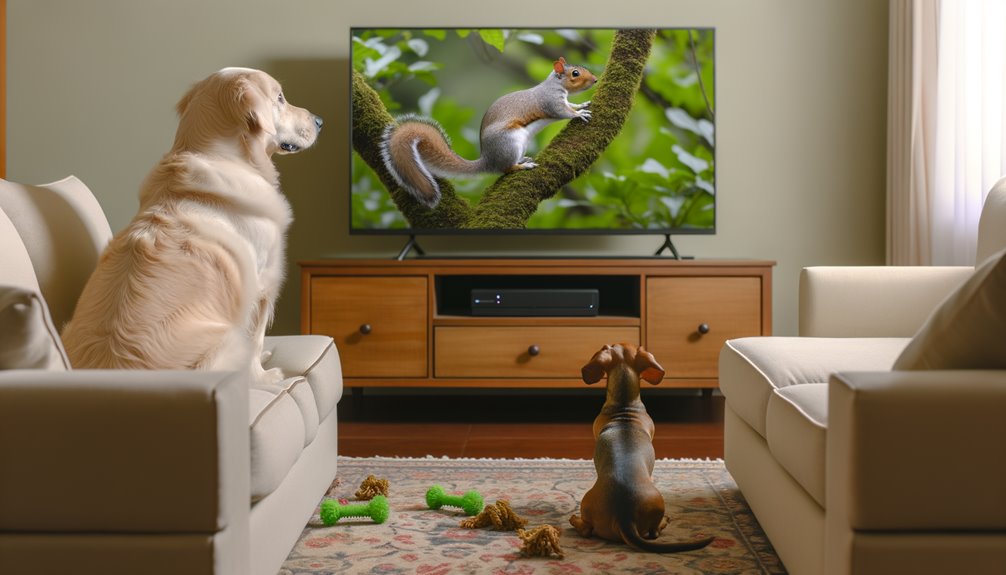Dogs generally enjoy watching TV content that features other animals, particularly those resembling themselves, engaging in active behaviors such as running and barking. Content with bright, dynamic visuals tends to capture their attention more effectively, with animal-centric programs, particularly nature documentaries and animated series with animal characters, being especially favored. The duration of viewing should be brief to maintain ideal engagement without causing overstimulation. Additionally, the type of content can influence a dog's behavior, sometimes provoking excitement or even mild aggression. By understanding their preferences and monitoring their reactions, owners can enhance their pet's mental well-being and entertainment experience.
Dog Viewing Preferences
While dogs may not be typical viewers, research indicates a clear preference among canines for television content that features other animals, particularly those of their own species.
Dogs engage more with TV videos displaying active behaviors like running or barking, especially sporting and herding breeds.
Their attention peaks with bright, dynamic visuals, favoring short viewing sessions geared towards animal-centric content.
Impact of Television
Television not only captivates human audiences but also plays a significant role in the mental and emotional well-being of dogs.
- Mental Stimulation: TV provides essential mental stimulation, reducing anxiety and boredom among dogs.
- Engagement Levels: Younger dogs show higher engagement, especially with animal videos featuring dogs.
- Behavioral Impact: Content type influences behavior, with intense scenes potentially provoking excitement or aggression.
Research Findings
Recent studies provide compelling insights into the viewing habits of dogs, revealing distinct preferences and behaviors.
Dogs demonstrate high engagement when watching videos with animal-related content, especially other dogs and nature documentaries. Active behaviors such as running and jumping are frequent.
Herding breeds show particular responsiveness to specific visual stimuli. However, older dogs' interaction declines, likely due to deteriorating vision affecting their screen preferences.
Preferred Video Content
Examining the preferred video content for dogs reveals some fascinating trends.
Dogs exhibit unique preferences when watching TV, showing a keen interest in:
- Nature Documentaries: 65% enjoy these, captivated by depictions of other animals.
- Animated Series: 76% are drawn to cartoons, especially those featuring animals.
- Car Shows: The movement in these shows keeps 82% of dogs engaged, underscoring their attraction to dynamic visuals.
Tips for Dog Owners
To optimize your dog's television viewing experience, it is essential for owners to monitor their pet's reactions to various shows.
Limit screen time to avoid overstimulation and choose content with bright colors and fast movement to engage them.
Consider your dog's breed and age, ensuring the environment is comfortable.
Observing their behavior helps tailor preferences for more enjoyable visual experiences.
Broader Animal Viewing
Why do so many dogs show a marked preference for watching other animals on screen? The content that features animals seems to specifically engage dogs, tapping into their natural behaviors and preferences.
- Cartoons: Dogs are drawn to the animated depictions of animals.
- Documentaries: Showcase real animal behavior and environments.
- Sports: Engage dogs, especially those involving dynamic movements like balls.
General Advice for Owners
While managing your dog's TV habits, it is essential to monitor their reactions to various shows to identify their preferences.
Limit screen time to prevent overstimulation, and choose content featuring animals to enhance engagement.
Create a comfortable viewing environment and observe behavior changes.
Engage your dog with interactive shows to boost their interest and enjoyment, ensuring a positive and enriching experience.
Frequently Asked Questions
What TV Shows Do Dogs Like Most?
Exploring canine preferences in TV shows reveals that dogs mainly enjoy animal documentaries and nature programs. These genres offer visual stimulation and sound effects that align with dog behavior, enhancing pet entertainment and engagement.
What Should I Leave on TV for My Dog?
For your dog, consider leaving the TV on dog-friendly channels featuring animal documentaries, nature programs, or animated pet movies. These can engage and entertain your pet, especially with visuals of wildlife adventures and other animals.
What Do Dogs Like to Look at on TV?
Dogs are drawn to TV content that aligns with their vision and interests, favoring moving objects, nature scenes, and animal sounds. They engage more with interactive content, training videos, and shows designed for pet-friendly viewing.
Do Dogs Enjoy Watching Dogs on TV?
Dogs exhibit significant engagement with television stimuli, particularly showing strong visual preferences and movement interest in canine behavior on screen. Their reactions suggest a robust attraction to animal shows featuring dogs, enhancing pet engagement during screen time.
Conclusion
To summarize, the research indicates that dogs exhibit specific preferences for television content, primarily favoring visuals that incorporate movement and animal figures. For owners, understanding these preferences can enhance a dog's visual and mental engagement. It is recommended that owners selectively expose their pets to television as a means to stimulate their sensory and cognitive functions. This approach should be integrated with regular physical activity and social interactions to guarantee a well-rounded environment for the animal's overall well-being.



